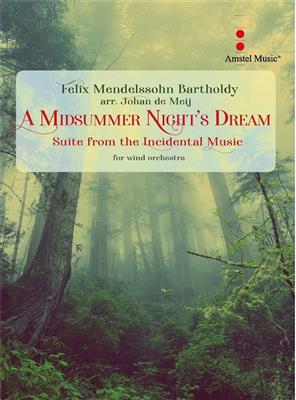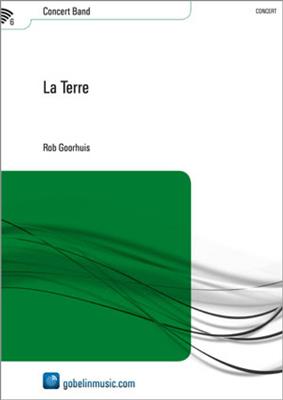Results
-
 £144.99
£144.99Ross Roy (Concert Band - Score and Parts) - De Haan, Jacob
Jacob de Haan was commissioned to compose this concert piece by the "St. Peters Wind Symphony" from Brisbane, Australia. "Ross Roy" is the monumental late 19th century villa where St. Peters Lutheran College was founded in 1945. The villa has always remained the school symbol. In this composition, Jacob de Haan sees the "Ross Roy" as a metaphor for the years spent at school (a monument in time), where one's personality is formed. So, the opening theme the artist calls the Ross Roy theme initially has monumental characteristics.The rhythmic motion, which strides along in the lower register and percussion at the beginning of the next section is typical of "Tempo di Marcia". This movement, accompanied by repetitions of sound, is a metaphor for the structure and discipline in school. This is the introduction to a march theme, symbolic of "passing through" the classes up to the final examinations.Then, the Ross Roy theme is dealt with again, now in a playful, humorous variation. As if the composer is saying there should also be time for a smile in school. The same theme can be heard in major key and a slower tempo in the following section, expressing pride and self-confidence. This is also the introduction to the expressive middle section that represents love, friendship and understanding.We then return to the march theme in a slightly altered construction. The oriental sounds, constituting the modulation to the final theme, are symbols of the diversity of cultures in the school. The characteristic final theme first sounds solemn, but turns into a festive apotheosis. It is no coincidence that the final cadence is reminiscent of the close to a traditional overture, for the school years can be considered the "overture" to the rest of one's life. The premiere of "Ross Roy" was conducted by Jacob de Haan in Brisbane, on August 22, 1997.Duration: 9:20
Estimated dispatch 7-14 working days
-
 £106.99
£106.99The River Knows Your Name - Jacob de Haan
This work describes the way the German river Saar holds the names of all the people who once lived in the area and of those who live there now. The introduction depicts the river flowing toward its confluence with the Mosel. The first names revealed by the river, in a dance, are those of the Romans, who established their first settlement here. Then the beautiful Saar Cathedral is portrayed, where believers give voice to the names of the people they know. Next, a powerful passage resounds: a reflection of the entrepreneurial spirit in Dillingen that has taken shape through the famous metal industry. Via a short clarinet solo, the work flows toward its conclusion in an emotional, stirring fashion, from nostalgic strains to full-blown euphoria.
Estimated dispatch 7-14 working days
-
 £119.60
£119.60In Flanders Fields - Guillaume Détrez
"In Flanders Fields" is a play recounting the Battle of Vimy Ridge (France) which took place from April 9 to 12, 1917. The introduction refers to the thousands of graves found at the site of Notre-Dame de Lorette. Then begins the episode of preparation and fierce battle. Thanks to the Canadian Expeditionary Force that came as reinforcements, the battle was won and the site secured at 6 a.m. (brass choir accompanied by 6 bells). The title of this work also refers to a poem by John Mac Rae located at the entrance to the memorial museum."In Flanders Fields"By Col. John McCrae,In Flanders Fields The poppies blowBetween the crosses row on rowThat mark our place; and in the skyThe larks, still bravely singing, flyScarce heard amid the guns below.We are the dead, short days agoWe lived, felt dawn, saw sunset glow,Loved and were loved and now we lieIn Flanders Fields.Take up our quarrel with the foeTo you, from failing hands, we throwThe torch, be yours to hold it high.If ye break faith with us, who dieWe shall not sleep, though poppies growIn Flanders Fields
Estimated dispatch 7-14 working days
-
 £99.99
£99.99Overture con Spirito - Thomas Doss
This work was commissioned by the Musikverein Prechtal e. V. (Germany) for its 100th anniversary in the year of 2021. The composition opens with a powerful rhythmic motif, which soon develops into the main theme of this brisk overture. The unwavering, joyful melodies and a positive atmosphere give the work a high-spirited energy. The strong pulse has the music firmly in its grasp and only quietens gradually in a pensive middle movement that seems to emanate from another world. This atmospheric passage can evoke dreamy thoughts and a variety of visions. But then the liveliness of the previous motifs returns, to take us back to the vivacious here and now, full of optimism and determination for the hundred years to come. On to a wonderful future!
Estimated dispatch 7-14 working days
-
 £67.50
£67.50Wedding March - Felix Mendelssohn Bartholdy
Felix Mendelssohn Bartholdy (1809 - 1847) composed the music for William Shakespeare's play A Midsummer Night's Dream at two different times. In 1826, at the age of 16, he wrote a concert overture (Op. 21). Sixteen years later, in 1842, he composed the incidental music (opus 61) for King Frederick William IV of Prussia, in which he incorporated the existing overture. The overture premiered in Stettin (then in Prussia, now Szczecin, Poland) on February 20, 1827, conducted by Carl Loewe. Mendelssohn had to travel 80 miles through a raging snowstorm to get to the concert, which became his first public appearance. The interlude between the 4th and 5th acts of the incidental music is the famous Wedding March, Mendelssohn's most popular and most performed work.
Estimated dispatch 7-14 working days
-
 £152.99
£152.99A Midsummer Night's Dream - Felix Mendelssohn Bartholdy
Felix Mendelssohn Bartholdy (1809 - 1847) composed the music for William Shakespeare's play A Midsummer Night's Dream at two different times. In 1826, at the age of 16, he wrote a concert overture (Op. 21). Sixteen years later, in 1842, he composed the incidental music (opus 61) for King Frederick William IV of Prussia, in which he incorporated the existing overture. The overture premiered in Stettin (then in Prussia, now Szczecin, Poland) on February 20, 1827, conducted by Carl Loewe. Mendelssohn had to travel 80 miles through a raging snowstorm to get to the concert, which became his first public appearance. The first British performance of the overture was conducted by Mendelssohn himself on June 24, 1829, at the Argyll Rooms in London. After the concert, Thomas Attwood was given the score of the overture for safekeeping, but left it in a taxi and was never found. Mendelssohn later rewrote the overture entirely from memory.
Estimated dispatch 7-14 working days
-
 £84.99
£84.99Georgia On My Mind
This jazz ballad from 1930 is probably one of the most covered standards of all times. The most famous interpretation dates back from 1960, covered by the one and only Ray Charles. Since then, in 1979 the song was declared the official state anthem for Georgia in the United States. Top arranger Peter Kleine Schaars has now made an amazing arrangement for band using the Ray Charles version it's so close to the original that you can still feel the vibe of the 60s.
Estimated dispatch 7-14 working days
-
 £53.50
£53.50Sadness and Sorrow - Purojekuto Musashi
As fans of Japanese anime will know, this popular ballad from the television series Naruto is filled with emotional depth and poignant beauty. Thanks in part to Taylor Davis' solo violin cover, this tune is now reaching a muchwider audience. Featuring a flute solo on the melody in the beginning then later scored for the full band, here is a sensitive adaptation for younger players.
Estimated dispatch 7-14 working days
-
£204.99
Credentium - Jan van der Roost
A spectacular dive via an extended chromatic scale immediately submerges us in a charged and somewhat archaic-feeling atmosphere. Trumpets, horns and trombones resound in rhythmic patterns, buttressed by restless motifs in the percussion. A second theme, in the woodwinds, begins much calmer but is quickly pushed aside by that same brass offensive. This introduction is the musical expression of the sometimes tumultuous early history of the town of Peer in Belgium. It closes with a D scale played over two octaves and repeated three times, symbolizing the church steeples that dominate the townscape. Peer has the credentials of a town, and people should know about it.There followsa rhythmic, turbulent passage: in the course of history, Peer has not been spared the ravages of war, arson, occupation, epidemic and other evils. In contrast, a slow, pastoral, lyrical part expresses the periods of peace and prosperity the town has known, as well as the serene geographic setting that still characterizes the place. Various instruments in groups are developed in solo style while the accompaniment displays vast, painterly images of sound. Now and then an exotic intonation is heard: a variety of peoples and cultures have left their mark on the town.This episode of tranquility and peacefulness comes to a sudden end when, via a surprising, almost chaotic transitional passage, we are in effect transported back to our own time. A hopeful, festive march expresses the confidence in the future that the Royal Concert Band of Peer exudes. This confidence is wholly justified: under the direction of conductor Willy Fransen, the 95 members of the concert band have experienced an extended period of good fortune, and the 75 musicians of the youth band - and the 45 little musicians of the mini-band - are involved in thriving operations.
Estimated dispatch 7-14 working days
-
 £209.99
£209.99La Terre - Rob Goorhuis
In the composition 'La terre' several aspects of Earth have been translated into sounds in an associative manner. The first part depicts Nature, Mother Earth, stability, the soil which is the source of life. Earth symbolizes tradition, rituals, fertility. In the music of the composition this can be heard in tonic and ostinato passages. Furthermore, human emotions such as gladness, sorrow, wonder, resignation, hope and despair, indissolubly connected as they are to mankind's life on earth, are musically reflected in sudden gusts of expression. Earth for us human beings is the solid ground on which everything in life takes place. In the second part different moodsare evoked in a sort of toccata. Now and then the music sounds fragmented, at other times as a solid whole. The robustness of the music in this part has its roots in the earth, originates from it. It reflects stability and strength, but love and nostalgia are also present in soft and fragile tones. 'La terre' is a musical narrative about Earth, in which music has been given ample room to show its many-sided beauty.
Estimated dispatch 7-14 working days
